
Installing the Clutch Rotor Assembly, Clutch
Field and Drive Shaft Assembly
1. If the drive shaft grease seal was removed, press a new
seal into the bore from which the old seal was removed.
2. From the clutch side of the gear housing, insert the drive
shaft assembly into the bore, through the grease seal, and
through the ball bearing on the gear side of the gear
housing.
3. From the gear side of the gear housing, insert the snap
ring into the groove on the drive shaft hub in front of the
ball bearing.
4. Place the housing gasket over the gear housing dowel pins.
5. Carefully place the pump housing assembly in front of the
gear housing assembly, lining up the gear housing dowel
pins with their corresponding holes in the pump housing.
Slide the pump housing onto the gear housing until there
is no gap between the housings and gasket.
Do not force the pump housing and gear housing together.
6. Locate the four socket screws and lock washers that secure
the pump housing to the gear housing. The longer screws
(2.25”) are fastened into the top internal holes. The shorter
screws (2”) are fastened into the bottom external bosses.
7. Using a 1/4” hex wrench, snug and tighten the socket
screws in a crossing pattern. Torque to 200–230 in./lbs.
8. Line up the four holes around the outside of the clutch
field with the four set screw holes in the gear housing.
The clutch field wires should be at approximately the 1 or
2 o’clock position.
9. Route the two clutch field wires through the grommet and
into the EPC housing.
10. Carefully slide the clutch field into its bore in the gear
housing until it “bottoms out” within the housing. Do not
pinch the clutch field wires during installation.
11. Thread one of the pointed set screws into its hole. Using
an 1/8” hex wrench, rotate the screw slowly until it
contacts the clutch field. Do not tighten the set screw.
The tip of the set screw should mate with the drill point
hole in the field. Check the clutch field for rotation. If it
rotates within its bore, the set screw is not seated within
the drill point.
12. When the set screw is properly seated, install the remaining
three pointed set screws. Do not tighten the set screws.
13. Using a crossing pattern, tighten each of the pointed
setscrews until they are snug. Once all four pointed set
screws are snug, use a crossing pattern to tighten and
torque the set screws to 60–70 in./lbs.
It is very important to evenly snug, tighten, and torque the
clutch field pointed set screws in a crossing pattern. This
ensures the clutch field will stay centered in the gear
housing.
CAUTION
CAUTION
Grease Seal
Bearing
Snap Ring
Small Snap Ring
Front Cover
Pump Housing Socket Screw
Front Cover Screw
Plug
Housing Gasket
12 ©Titan Tool Inc. All rights reserved.
14. Install the remaining four set screws over the four pointed
set screws. Using an 1/8” hex wrench, tighten each of the
set screws in a crossing pattern until they are snug. Once
all four set screws are snug, use a crossing pattern to
tighten and torque the set screws to 60–70 in./lbs.
15. Line up the three screw holes and dowel pin hole on the
clutch rotor with the screw holes and dowel pin on the drive
shaft assembly hub. Place the clutch rotor onto the hub.
16. Using a 3/16” hex wrench, thread the three socket screws
and lock washers through the clutch rotor and into the
drive shaft assembly hub. Evenly snug, tighten, and
torque the socket screws to 75–85 in/lbs.
17. Make sure the friction surface of the clutch rotor is clean
and free from oil or grease.
Electrostatic discharge (ESD) potential could cause
damage to electronic pressure control. Use Titan ESD
wrist strap P/N 700-1037 or equivalent when working on
electronic pressure control.
18. Locate the two clutch field wires in the EPC housing.
Gently pull the wires fully into the EPC housing so that
there is no slack in the gear housing. Connect the wires
to their proper terminals on the EPC board (refer to the
labels created earlier in this procedure or the electrical
schematic in the Parts List section of this manual).
19. Carefully place the EPC assembly over the EPC housing
taking care not to pinch any wires.
20. Install the four screws that secure the EPC assembly to
the EPC housing. Tighten securely.
Mating the Gear Housing and the Clutch
Housing
1. Place the gear housing assembly onto the cart in front of
the clutch housing. Line up the dowel pins in the gear
housing with their corresponding holes in the clutch
housing. Slide the gear housing assembly onto the clutch
housing until there is no gap between the housings.
2. Thread the four hex screws and lock washers through the
clutch housing and into the gear housing.
3. Using a 1/2” wrench, snug and tighten the hex screws in a
crossing pattern. Torque to 140–155 in./lbs.
4. Using a 9/16” socket, thread the two hex screws that secure
the gear housing to the cart through the underside of the
cart and into the gear housing. Torque to 100–120 in./lbs.
5. Connect the wire from the EPC housing to its mating
connector on the engine wire harness.
6. Make sure that there is a white PTFE o-ring on the end of
the transducer that gets inserted into the filter housing.
Insert the transducer into the filter housing port.
7. Hold the transducer tube with a pliers to prevent it from
rotating, and turn the transducer nut clockwise with a 3/4”
open-end wrench to tighten it into the filter housing.
Torque the nut to 360–400 in./lbs.
Checking the Clutch Gap
1. Remove the plastic plug from the top of the clutch
housing. Look through the port to locate the clutch
armature and the clutch rotor.
2. Check the gap between the clutch armature and the clutch
rotor using a .016” feeler gauge and a .035” feeler gauge.
a. Insert each feeler gauge through the port and into the
gap between the clutch armature and the clutch rotor.
The .016” feeler gauge should fit in the gap. The .035”
feeler gauge should not fit in the gap.
b. Pull the engine pull cord several times to rotate the
clutch armature, checking the gap with each feeler
gauge between each pull.
c. If the .016” gauge does not fit or the .035” gauge does fit
at any checkpoint, the gap must be readjusted. This is
done by relocating the clutch hub and armature assembly
on the engine shaft. Refer to the “Removing/Replacing
the Clutch Armature Assembly” procedure.
WARNING























